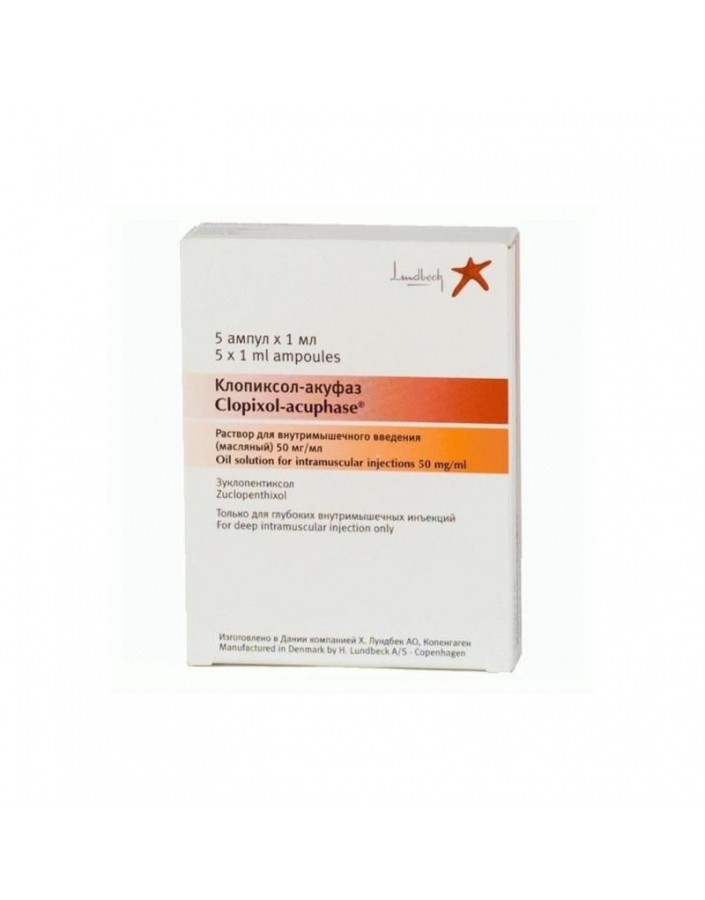




Security policy (edit with Customer reassurance module)

Delivery policy (edit with Customer reassurance module)

Return policy (edit with Customer reassurance module)
1 ml of oil solution for intramuscular administration contains: Zuclopentixol decanoate 50 mg.
5 vials of 1 ml.
Klopiksol-Akufaz has a neuroleptic, antipsychotic, sedative effect. Blocks dopamine receptors in the brain.
Acute and chronic schizophrenia and other psychotic disorders, especially with hallucinations, paranoid delusions, impaired thinking; the state of agitation, increased anxiety, hostility, aggressiveness; manic phase of manic-depressive psychosis; mental retardation, combined with psychomotor agitation, agitation, and other behavioral disorders; senile dementia with paranoid ideas, confusion, disorientation, behavior disorders.
Acute alcohol poisoning, barbiturates, opiates; coma.
Use during pregnancy and lactation
Contraindicated. Nursing mothers should stop breastfeeding.
Klopiksol-akufaz is appointed in the form of a deep intramuscular injection in the upper outside quadrant of the gluteal region. Local tolerance is good.The dosage is selected individually depending on the patient's condition.
The recommended volume of intramuscular injection of 1-3 ml (50-150 mg). If necessary, repeated injections are carried out at intervals of 2-3 days. For some patients, an additional injection may be given 24-48 hours after the first injection.
When switching to Clopixol oral administration after 2-3 days after the final injection of Klopiksol-Akufaz (100 mg injection), the patient should be orally administered a daily dose of 40 mg, if possible in several doses. If necessary, the dose may be increased by 10-20 mg every 2-3 days up to 75 mg / day or more.
Extrapyramidal disorders, tardive dyskinesia, neuroleptic malignant syndrome, drowsiness, dizziness, dry mouth, accommodation disturbance, urinary retention, constipation, tachycardia, orthostatic hypotension, changes in liver tests are possible.
Malignant neuroleptic syndrome (NNS) is a rare but possible complication with a fatal outcome when using neuroleptics. The main characteristics of the NMS are hyperthermia, muscle rigidity and impaired consciousness in combination with dysfunction of the autonomic nervous system (labile blood pressure, tachycardia, increased sweating). In addition to the immediate cessation of neuroleptic intake, the use of general supportive measures and symptomatic treatment is urgently needed.
Enhances the sedative effect of alcohol, barbiturates and other means of oppressive central nervous system, reduces - levodopa and other adrenergic agents. Weakens the hypotensive effect of guanethidine and its analogues. The risk of extrapyramidal disorders increase Metoclopramide and piperazine.
Symptoms: drowsiness, hypo-or hyperthermia, hypotension, extrapyramidal symptoms, convulsions, shock, coma.
Treatment: symptomatic and supportive. Measures should be taken to support the activity of the respiratory and cardiovascular systems. Do not use epinephrine (adrenaline), because this can lead to a subsequent lowering of blood pressure. Spasms can be stopped by diazepam, and extrapyramidal symptoms biperidenom.
At temperatures not above 25 ° C.